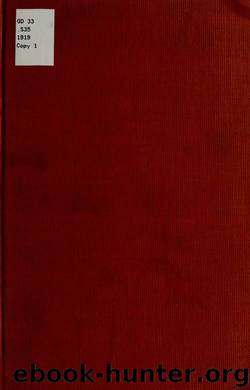An introductory course of lessons and exercises in chemistry (rewritten 1919) by Schoch Eugene Paul 1871-

Author:Schoch, Eugene Paul, 1871- [from old catalog]
Language: eng
Format: epub
Tags: Chemistry
Publisher: [Austin] The Chemical laboratory of the University of Texas
Published: 1919-03-25T05:00:00+00:00
10. Effects Produced by the Addition of Ammonium Chloride and Ammonia to Solutions of Salts of Common Metals.
Na% K + , Ca + + , Sr + + , Ba + + :—no effect whatever because the hydroxides of these metals are strong bases.
Ag + :—forms a ppt. of AgCl, which is dissolved by ammonia to form Ag(NH 3 ) 2 Cl. This compound tends to dissociate into its original constituents—
Ag(Jm,) ,C1 ^± AgCl-f-2HN 3 ,
and it is stable only in the presence of free NH 3 . Hence, when the excess of N~H, in these solutions is neutralized by the addition of an acid to the mixture, the insoluble AgCl is obtained again.
Pb + + :—forms a ppt. of PbCl 2 , and this is changed by ammonia to Pb(OH)Cl, an insoluble white compound.
Hg + :—forms a ppt. of Hg 2 Cl 2 , and this is changed by ammonia to a Hack, insoluble mass, admixture of mercury and of the compound HgCl NH 2 , according to the equation:
Hg 2 CL+2NH 4 0H=HgClNH,,+NH 4 C]+Hg+2H 2 0.
Hg + + :—gives, on the addition of ammonia, HgClNH 2 , a white compound insoluble in water. Treated with HC1, it forms HgCl.+NHjCl, which are soluble.
Cu + + , Cd + + , Zn + + , M + + :—they form soluble compounds of the general formula M(KrL) 4 Cl 2
Or M(NH 3 ) 4 S0 4 .
The cations of these salts are: Cu(NH 3 ) 4 ++ , Cd(NH 3 V + , Zn(NH 3 ) 4 ++ , M(M ; ) 4 ++ . With colored salts—such as those of Cu + + and Ni + + —the formation of the complex ions shows itself by a great deepening of the color.'
The ammonia compounds tend to dissociate into their original constituents—
Cu(NH,) 4 S0 4 ±^CuS0 4 +l:NH 3 ,
and they are stable only in the presence of free NTE 8 . Hence when the excess of NH 3 in these solutions is neutralized by the addition of an acid, the original simple salts (e. g., CuS0 4 , in the illustration above) are obtained again.
Fe + + and Mn + + :—these cations are not affected directly by N"H i Cl-j-NH 4 0H, but in alkaline solutions they exert a great tendency to change to the trivalent form—Fe + + + and Mn ++ + — hence on contact with the air, these mixtures turn dark and gradually form precipitates of Fe(OH).. and Mn(OH) 3 , respectively, because the change to the trivalent form is brought about by the oxygen of the air, according to the equation:— 2Fe(OH) 2 -fO+H,0=2Fe(OH) 3 .
Mg + + :—not affected by NH 4 C1+NH 4 0H.
Bi + * + . Fe + + + . A1 + + + :—theso ions are precipitated completelv as hydroxides, Bi(OH) 3 , Fe(OH) 3 , A1(0H) 3 .
Download
This site does not store any files on its server. We only index and link to content provided by other sites. Please contact the content providers to delete copyright contents if any and email us, we'll remove relevant links or contents immediately.
Whiskies Galore by Ian Buxton(41550)
Introduction to Aircraft Design (Cambridge Aerospace Series) by John P. Fielding(32900)
Rewire Your Anxious Brain by Catherine M. Pittman(18335)
Craft Beer for the Homebrewer by Michael Agnew(17944)
Cat's cradle by Kurt Vonnegut(14798)
Sapiens: A Brief History of Humankind by Yuval Noah Harari(14004)
Leonardo da Vinci by Walter Isaacson(12828)
The Tidewater Tales by John Barth(12412)
Underground: A Human History of the Worlds Beneath Our Feet by Will Hunt(11851)
Thinking, Fast and Slow by Kahneman Daniel(11825)
The Radium Girls by Kate Moore(11644)
The Art of Thinking Clearly by Rolf Dobelli(9947)
A Journey Through Charms and Defence Against the Dark Arts (Harry Potter: A Journey Throughâ¦) by Pottermore Publishing(9144)
Mindhunter: Inside the FBI's Elite Serial Crime Unit by John E. Douglas & Mark Olshaker(8741)
Tools of Titans by Timothy Ferriss(7839)
Wonder by R. J. Palacio(7751)
Turbulence by E. J. Noyes(7725)
Change Your Questions, Change Your Life by Marilee Adams(7395)
Nudge - Improving Decisions about Health, Wealth, and Happiness by Thaler Sunstein(7269)
